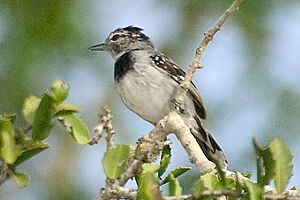Pectoral antwren facts for kids
Quick facts for kids Pectoral antwren |
|
|---|---|
 |
|
| Conservation status | |
| Scientific classification | |
| Genus: |
Herpsilochmus
|
| Species: |
pectoralis
|
 |
|
The pectoral antwren (Herpsilochmus pectoralis) is a small bird found only in Brazil. It belongs to a group of birds called "typical antbirds." This special bird is currently listed as a vulnerable species. This means its numbers are going down, and it needs our help to survive.
Contents
About the Pectoral Antwren
How Scientists Classify This Bird
The pectoral antwren was first described in 1857 by an English zoologist named Philip Sclater. He gave it the scientific name Herpsilochmus pectoralis. This name helps scientists around the world know exactly which bird they are talking about.
Scientists are still learning about how the pectoral antwren is related to other birds. It seems to be most closely related to the large-billed antwren. Some experts even think they might be part of a "superspecies," meaning they are very closely related. The pectoral antwren is considered a "monotypic" species. This means it doesn't have any different subspecies or types within it.
What Does the Pectoral Antwren Look Like?
The pectoral antwren is a small bird, about 11 to 12 centimeters (4.3 to 4.7 inches) long.
Male Pectoral Antwrens:
- They have a black cap on their head and neck.
- There are white spots around the black cap.
- A long, whitish stripe goes above their eye, like an eyebrow.
- A thin black line runs through their eye.
- Their cheeks are grayish.
- Their back and rump are gray.
- They have a black and white patch between their shoulders.
- The feathers on their upper tail have white tips.
- Their wings are black with white tips on some feathers.
- The innermost tail feathers are black with white edges.
- The outermost tail feathers are completely white.
- The feathers in between are black with white tips.
- Their throat and belly are mostly white.
- They have a black patch on their chest.
- Their sides are gray.
Female Pectoral Antwrens:
- They have a reddish-brown cap on their head.
- Their upper body is brownish-olive.
- Their wing feathers have buff (pale yellowish-brown) edges.
- The sides of their neck and their underparts are buff-colored.
- Their tail looks similar to the male's.
Where the Pectoral Antwren Lives
The pectoral antwren lives only in Brazil, but its populations are spread out. One group lives in far northeastern Brazil, from Rio Grande do Norte south to Sergipe and northeastern Bahia. Another group lives a bit further west in Maranhão. In both areas, you can only find this bird in certain spots.
The birds in Maranhão live in forests where trees lose their leaves and in "gallery forests" (forests along rivers). In Rio Grande do Norte, they live in restinga woodlands, which are coastal forests. Further south, they prefer tall caatinga woodlands and older re-grown forests. These birds don't seem to prefer a specific height in the forest. They can be found from sea level up to about 850 meters (2,789 feet) high.
Pectoral Antwren Behavior
Movement and Home Range
Scientists believe that the pectoral antwren stays in the same area all year long. It does not migrate to different places.
What and How They Eat
We don't know all the details about what the pectoral antwren eats. However, we know its diet includes insects and likely spiders. These birds often search for food alone, in pairs, or with their families. They also frequently join "mixed-species feeding flocks." This means they team up with other types of birds to find food.
They usually look for food between 2.5 and 7 meters (8 to 23 feet) above the ground. Sometimes, they go as high as 12 meters (39 feet). They rarely look for food on the ground. Pectoral antwrens are active and careful foragers. They usually catch their prey by picking it off leaves, stems, and vines. They might reach out or lunge from their perch. They also often make short flights to quickly grab insects while hovering. They are not known to follow army ants, which some other antbirds do.
Reproduction and Life Cycle
The exact breeding season for the pectoral antwren is not fully known. However, we know they breed during August and September. Unfortunately, not much else is known about how these birds raise their young.
Their Calls and Songs
The pectoral antwren has a unique song. It's described as a "high, very fast chattering series of 'tututjdrrrrrr' notes." The song starts quite high and might end by dropping slightly. Their call is a flat sound, like "caa."
Protecting the Pectoral Antwren
The IUCN (International Union for Conservation of Nature) first listed the pectoral antwren as "Threatened" in 1988. Since 1994, it has been listed as "Vulnerable." This means the bird faces a high risk of becoming extinct in the wild.
The pectoral antwren's habitat is broken up, especially in Maranhão. Experts estimate there are only between 2,500 and 10,000 adult birds left. This number is believed to be shrinking. We don't fully understand all the threats to this bird. However, forests are being cleared for farms that use irrigation and for dry farming. This removes large areas of the deciduous forest where they live. Also, intense grazing by animals and widespread burning are common in their habitat.
The pectoral antwren lives in only one small protected area, which is in Sergipe. More studies are needed to find out exactly where these birds live and how many there are. This information will help create more small protected areas to keep them safe.


